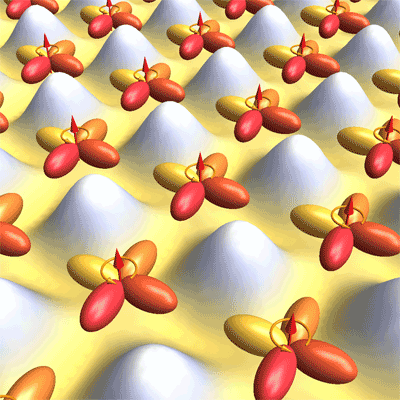Topological matter in optical lattices

Atoms trapped by laser light have become excellent platforms for simulating solid state systems. These systems are also a playground for exploring quantum matter and even uncovering new phenomena not yet seen in nature.
Researchers at the Joint Quantum Institute have shown that an optical lattice system exhibits a never-before-seen quantum state called a topological semimetal. The semimetal, which debuts in this week’s Advance Online Publication for the journal Nature Physics, can undergo a new type of phase transition to a topological insulator.
Topological insulators are one of the hottest topics in condensed matter research because of their dual-personality. They are insulators throughout the bulk of the material but are conductors along the edges. Harnessing the underlying phenomena, known as quantum hall physics, is important for developing new types of electronics and quantum information.
Scientists can create this unusual behavior in certain two-dimensional materials--such as a layer of electrons at the interface between two semiconductors-- by employing extremely large magnetic fields. What makes topological insulators special is their ability to exhibit this physics without external magnets.
JQI postdoctoral fellow Kai Sun explains, “Magnetic fields and lattices have nothing to do with topology. If a particular quantum hall state is topological matter, then I should be able to create it in different ways just by constructing the right topology.”
While experiments using these new materials have made great advances, hurdles such as achieving the necessary sample purity, remain. Additionally, real-time control over experimental conditions can be quite difficult and in some cases, not possible.
In the paper, the team proposes an atom-optical lattice system as the ideal test bed. Ultracold gases offer versatility for studying topological matter [see Topology inset] because a single apparatus can be used for repeated experiments. Here, researchers are able to alter the effective material through adjusting laser power.
Kai Sun explains that these advantages motivated the team to “design a system to realize topological state that has not been seen in condensed matter systems.”
An ultracold gas may not sound like a solid, but under certain conditions, this unusual quantum matter behaves just like a crystal made in nature. Neutral atoms trapped by a checkerboard of laser light are analogous to electrons in a crystalline solid. The light intensity determines the mobility of the atom gas around the lattice. If the atoms do not interact with each other, an energy band structure emerges that represents the semimetal. This semimetal has special properties that allow it to transform into topological insulator when the atoms begin to interact.
What is a semimetal?
Condensed matter physicists classify materials according to their conductivity: insulators and metals. This property is related to the ability for electrons to leave their parent atoms and become mobile in a material.
In a single atom, electrons are restricted to certain energy levels. When many atoms form a solid, the individual energy levels mesh together and a new energy spectrum arises for the sea of electrons in a material. This is called a material’s band structure, where bands and gaps represent allowed and forbidden electron energies, respectively.
A valence band encompasses all the allowed energies if a solid were at absolute zero temperature. Electrons fill the valence band and are relatively localized to their parent atoms in the solid. Above the valence band is a conduction band, a zone that can be occupied but only if the electron somehow gains enough energy to overcome the forbidden gap region, becoming mobile.
So what makes a material an electrical conductor, or metal? Insulators have a gap between this conduction zone and valence band that exceeds the energy of the electrons. A well-known subset of insulators, called semiconductors, has a gap small enough that they can only conduct under certain conditions. Metals have no gap, so they are naturally conductive. This topological semimetal has no gap, but only at a small point in the energy spectrum. [see Figure 1]

Starting with the semimetal, these researchers show that allowing the particles to interact disrupts the system and forces a phase transition. Previously studied topological insulators are the result of single particles interacting with a type of internal magnetic field (called spin-orbit coupling).
W. Vincent Liu, co-author and professor at University Pittsburgh, explains this key feature, "A most exciting aspect of this research is that we seem to have found a first example of optical lattice gases that can reveal a quantum Hall-like topological state without needing an external magnetic field or spin-orbital coupling. Instead it is due to the effects of internal many-body interactions."
The team found that upon adding these interactions the particles spontaneously began to rotate [see Figure 2/animation]. Normally, lasers can generate rotation, either by stirring the sample or engineering effective magnetic fields. The proposal here offers not only novel states, but the spontaneously generated rotation may be a complementary experimental technique.
The proposed experiment uses established atomic physics techniques. Combining these ingredients may prove tricky, but would certainly open new possibilities for studying condensed matter physics.
More information: 1. “Topological semimetal in a fermionic optical lattice,” Kai Sun, W. Vincent Liu, Andreas Hemmerich, and S. Das Sarma, Nature Physics, DOI:10.1038/NPHYS2134 (2011)
2. “Fractional quantum Hall effect in the absence of Landau levels,” D.N. Sheng, Zheng-Cheng Gu, Kai Sun, and L. Sheng, Nature Communications, 2, 389, (2011)
3. “Nearly Flatbands with Nontrivial Topology,” Kai Sun, Zheng-Cheng Gu, Hosho Katsura, and S. Das Sarma, Physical Review Letters, 106, 236803, (2011)
[Accompanying Physics Viewpoint]
Journal information: Nature Communications
Provided by University of Maryland



















